КАРТА САЙТА

Напишите ваш запрос
Менеджер свяжется с вами для уточнения деталей. После мы отправим предложение с описанием решения вашей задачи, условиями работы и стоимостью
Нажимая на кнопку, вы даете согласие на обработку персональных данных и соглашаетесь c политикой конфиденциальности

Напишите ваш запрос
Менеджер свяжется с вами для уточнения деталей. После мы отправим предложение с описанием решения вашей задачи, условиями работы и стоимостью
Нажимая на кнопку, вы даете согласие на обработку персональных данных и соглашаетесь c политикой конфиденциальности
ДАЙДЖЕСТ
Beauce Gold Fields Using New Geophysics Technology to Survey Along the St-Gustave Road over the Old Placer Gold Mine

Mr. Patrick Levasseur reports:
Montreal, Quebec--(Newsfile Corp. - March 19, 2019) - Beauce Gold Fields (TSX: BGF) (Champs D'Or en Beauce) (BGF) (Bourse de croissance) is pleased to announce that it is presently conducting a high resolution mobile electromagnetic (TDEM) survey using a new Russian technology. This survey is being done on Rang St-Gustave Road in St-Simon-les-Mines, which is located in the Beauce region of southern Quebec.
Montreal, Quebec--(Newsfile Corp. - March 19, 2019) - Beauce Gold Fields (TSX: BGF) (Champs D'Or en Beauce) (BGF) (Bourse de croissance) is pleased to announce that it is presently conducting a high resolution mobile electromagnetic (TDEM) survey using a new Russian technology. This survey is being done on Rang St-Gustave Road in St-Simon-les-Mines, which is located in the Beauce region of southern Quebec.
A geophysical survey along Rang St-Gustave Road (HPQ May 11, 2017 release,) had already identified a major fault under the former Beauce Placer Company placer gold mine of the 1960s and under the former Champs D'Or Rigaud Vaudreuil, St-Gustave mine of 1910.
Quebec, Canada

The geophysical team currently consists of a team from the INRS (Institute National de la Recherche et des Sciences), led by Professor Marc Richer-LaFlèche, and two geophysicists from Aerogeophysical Surveys (Russia). The work is a continuation of the geophysics that has been carried out by HPQ Silicon in the sector since 2017. The primary objective of the geophysical survey is to identify potentially mineralized zones that could possibly be the hard rock source of the gold contained in the placers of St-Simon-les-Mines.
Robert Gagnon, P. Geo., a qualified person as defined by NI 43-101, has reviewed and approved the technical information presented in this release.
This technology measures electrical chargeability (induced polarization) and electrical conductivity at a horizontal resolution of 15cm. In addition, it allows a vertical penetration at depth to the order of 200m. The method is optimal for detecting narrow ore bodies (auriferous zones) and for prospecting within conductive geological stratums that are particularly frequent in the Beauceville Formation and throughout the Bellechasse gold belt.
Mobile high resolution TDEM system deployed on Rang St-Gustave
Junior Mining Network
junior-miner-news
press-releases
junior-miner-news
press-releases
Patrick Levasseur, President and CEO of Beauce Gold Fields, said, "Using this new state-of-the-art exploration technology will add to our understanding of the geology and help us reach our goal of finding a hard rock source of the famous Beauce's placer gold deposits."
Preliminary testing along a local road has detected conductors and areas of high induced polarization (IP) in both conductive (shales) and resistive (sandstones and volcanic rocks) zones, suggesting the presence of disseminated sulphides, said Marc Richer-Lafleche, a professor at the Institute National de la Recherche Scientifique (INRS) in Quebec City, who is leading Beauce's geophysical team.
More recent discoveries of gold in the saprolite -- formed by deep weathering of the bedrock surface -- suggest that the source lies nearby, but a one- to 25-metre thick cover of quaternary till and dense forest have made prospecting in the area a challenge.
Exploring with electromagnetism. New surveying technology to find a historic gold deposit
Canadian Institute of Mining, Metallurgy and Petroleum.
CIM Magazine
Technology
CIM Magazine
Technology

The time-domain electromagnetic (TDEM) system can identify the conductive black shales that stymied previous exploration attempts. Courtesy of Beauce Gold Fields.
Montreal-based Beauce Gold Fields is using a time-domain electromagnetic (TDEM) system developed in Russia to find the hard rock source of the Beauce placer gold deposits in southern Quebec.
Montreal-based Beauce Gold Fields is using a time-domain electromagnetic (TDEM) system developed in Russia to find the hard rock source of the Beauce placer gold deposits in southern Quebec.
The company hopes that by separating out induced polarization (IP) and conductivity measurements, the high-resolution system will be able to see past the conductive black shales – commonly mistaken for sulphides – that have stymied previous geophysical attempts to detect the source of the gold in the Gilbert River Valley near St-Simones-les-Mines, about 100 km south of Quebec City.
Richer-Lafleche decided to give the mobile TDEM system a try after reading several articles written by Professor Georgy Trigubovich and Dr. Anton Chernyshev of Aerogeophysical Surveys, a leading airborne geophysical company in Russia. Trigubovich, the deputy director of science in geophysics at the Siberian Research Institute of Geology, Geophysics and Mineral Resources, has developed a number of innovative techniques to improve the reliability of resource predictions. His academic colleague Chernyshev specializes in using mathematical methods to solve geophysical problems.
"This demonstrates the importance of being able to separate the electrical conductivity and induced polarization components," he said. Added to that feature is a horizontal resolution of about 15 centimetres, allowing the team to detect relatively narrow sulphide mineralized bodies, such as gold veins.
The Beauce ground survey follows an audio magnetotelluric, gravimetric and geological survey conducted by INRS to detect discontinuities that might represent faults or shear zones that could be conduits for gold mineralization. The comprehensive survey detected a 1,500-metre-deep structure underneath the placer deposits and multiple conductors that could be either graphite or sulphide mineralization. The TDEM survey will better characterize the location and physical characteristics of these anomalies.
In 1846, the discovery of a 2.5-ounce nugget in the St. Gilbert River near St-Simon-Les-Mines triggered Canada's first gold rush. Beauce, formerly HPQ Silicon Resources, holds claims covering a six-kilometre-long unconsolidated sedimentary unit that hosted placer gold mines from the 1860s to the 1960s. Although the mines produced an estimated 1.5 short tons of gold, the source of the placer deposits has never been found.
According to Richer-Lafleche, the Russian technology has located both gold and diamondiferous kimberlites in Siberia. It has been adapted to operate on relatively narrow Canadian forest roads and can be towed behind a snowmobile on land and behind a boat on lakes and rivers.
The system uses an induction loop powered by currents of 10 to more than 50 amps and two receiving antennas positioned to allow optimal decoupling of conductivity and IP. Depending on the power of the current, the number of turns of the induction loop and the conductivity of the ground, the system can probe depths of up to 250 metres.
"The critical point of the method is the configuration of the transmitter-receiver system and the quality of the algorithms used to separate the electrical conductivity and IP components," said Richer-Lafleche, who is also testing the technology on Falco Resource's Noralex project in the Rouyn-Noranda mining camp, where historical drilling returned low-grade gold values over wide intercepts.
Beauce is currently using the system on country roads and will expand the survey to agricultural fields and private forest roads at the end of the year. "Using this new state-of-the-art exploration technology will add to our understanding of the geology and help us reach our goal of finding a hard rock source of the famous Beauce placer gold deposits," said Beauce president Patrick Levasseur.
Quebec, Canada
By Virginia Heffernan
May 09, 2019
May 09, 2019
Пресс-центр ГУП "Регионалгеология"
28.06.2019
28.06.2019
Поставка вертолетной платформы Импульс-А450 для нужд Государственного Комитета по геологии и минеральным ресурсам Республики Узбекистан
На территории Навоийской и Самаркандской областей республики Узбекистан силами «Центральная ГГЭ» и ЗАО «АГР», завершены ОМР с целью внедрения в Узбекистане современного аэрогеофизического комплекса «Impulse-А- 450» (гаммаспектрометрия ,38 литров , магнитометрия, аэро-ЗСБ (500-700 м).
Первый этап аэрогеофизических работ в Узбекистане с ГУП "Регионалгеология"
Узбекистан
Навоийская и Самаркандская область
Навоийская и Самаркандская область
Полученные в результате ОМР аэрогеофизические данные (М, ТЕМ, Gamma-Ray) cоответствуют заявленным характеристикам.
Узбекистан
Навоийская и Самаркандская область
Навоийская и Самаркандская область
Второй этап аэрогеофизических работ в Узбекистане с ГУП "Регионалгеология"
10 сентября произведена доставка комплекта оборудования Импульс-А-7-450, подготовлена вертолетная площадка, где производится установка и монтаж оборудования на вертолет МИ-8МТВ-1. Работы будут выполняться совместно со специалистами ЗАО «Аэрогеофизическая разведка» (Новосибирск) , разработчиками аэро-геофизического комплекса А-450.
В соответствии с постановлением Кабинета Министров Республики Узбекистан и Госпрограммой развития и воспроизводства МСБ на 2019г. ГП «Центральная ГГЭ» проводит аэрогеофизические исследования методами магниторазведки, электроразведки и гамма-спектрометрии.
Пресс-центр ГУП "Регионалгеология"
11.09.2019
11.09.2019
Геологическим заданием проекта предусмотрено выполнение опытно-методических работ с целью освоения и внедрения в производство современного аэрогеофизического комплекса, разработки технологии и приемов проведения съемки геофизических и геохимических полей, общей площадью 1 600 км2. С 12 апреля по 15 мая т.г. были проведены и своевременно завершены опытно-методические аэрогеофизические работы на участке работ в Зиаэтдинских горах Новоийской области общим объемом 1000 кв.км.
Результаты работ
Место проведения работ
ПИ
Назначение работ
Технология
Оборудование
р. Узбекистан
золото, медь, молибден
выделение рудных объектов медно-порфирового типа
аэро-ЗСБ, магниторазведка, гамма-спектрометрия
комплекс «Импульс-А7-450» (ЗАО «Аэрогеофизическая разведка», Россия)
аэромагнитометр CS-3 (Scintrex LTD, Канада),
спектрометр RSX-5 серии RS-500 (производитель Radiation Solutions Inc., Канада)
навигационная система НК «Аэронавигатор плюс» (Аэросоюз», Россия), радиовысотомер РВ-5М,
магнитовариационная станция (магнитометр POS-1).
аэромагнитометр CS-3 (Scintrex LTD, Канада),
спектрометр RSX-5 серии RS-500 (производитель Radiation Solutions Inc., Канада)
навигационная система НК «Аэронавигатор плюс» (Аэросоюз», Россия), радиовысотомер РВ-5М,
магнитовариационная станция (магнитометр POS-1).
Решен обширный блок геокартировочных задач и выполнены прогнозные построения по локализации рудных объектов искомого типа. По совокупности данных на площади выделено 7 структурно-вещественных комплексов (СВК), формирующих основные черты геологического строения.
СВК обладают уникальными сочетаниями геофизических показателей и диагностируются однозначно. Среди них выделен рудовмещающий и образования, относимые к источникам оруденения, включая перекрытые.
Широко проявленные разрывные нарушения сгруппированы в 3 системы, одна из которых отнесена к рудоконтролирующей. Выделены крупные тектонические блоки и многочисленные зоны минерализации, включая метасоматиты рудной природы.
Прогнозные построения подтверждены результатами статистического анализа, выполненного различными способами. На рис.3 представлены итоги обработки способом К-средних (динамических сгущений), где красными тонами отмечены таксоны рудной природы.
Базируясь на разработанной ФГМ, с учетом всей полученной информации осуществлена локализация рудных объектов. По специфическим сочетаниям геофизических показателей выделено два типа оруденения – кальмакырский и сарычекуский.
По степени полноты пакета рудоконтролирующих факторов, контрастности геофизических аномалий и их размеров локализованы перспективные геофизические участки первой (ПГУ-1) и второй (ПГУ-2) очереди заверки.
На территории обособлено три ПГУ-1 и девять ПГУ-2. Осредненная площадь ПГУ составляет менее 1 кв. км. Последующее сопоставление данных КВГС, наземной геофизики и литогеохимиии по вторичным ореолам установило высокую достоверность геофизического прогноза. 9 из 12 ПГУ охватывают наиболее контрастные ореолы золота и ВП. Остальные участки могут контролировать невскрытое оруденение.
Место проведения работ
ПИ
Назначение работ
Технология
Оборудование
Узбекистан
Третий этап аэрогеофизических работ в Узбекистане с ГУП "Регионалгеология"
Пресс-центр ГУП "Регионалгеология"
29.06.2020
29.06.2020
Место проведения работ
Технология
Оборудование
р. Узбекистан
аэро-ЗСБ, магниторазведка, гамма-спектрометрия
комплекс «Импульс-А7-450» (ЗАО «Аэрогеофизическая разведка», Россия)
аэромагнитометр CS-3 (Scintrex LTD, Канада),
спектрометр RSX-5 серии RS-500 (производитель Radiation Solutions Inc., Канада)
навигационная система НК «Аэронавигатор плюс» (Аэросоюз», Россия), радиовысотомер РВ-5М,
магнитовариационная станция (магнитометр POS-1).
аэромагнитометр CS-3 (Scintrex LTD, Канада),
спектрометр RSX-5 серии RS-500 (производитель Radiation Solutions Inc., Канада)
навигационная система НК «Аэронавигатор плюс» (Аэросоюз», Россия), радиовысотомер РВ-5М,
магнитовариационная станция (магнитометр POS-1).
В соответствии с утвержденной Программой геологоразведочных работ Государственного Комитета по геологии и минеральным ресурсам ГУП «Регионалгеология» начала работы по новому проекту: «Комплексная аэрогеофизическая съёмка в масштабе 1:25 000 в горах Кульджуктау, северо-западной части гор Букантау и горах Мальгузар»
Супервайзинг аэрогеофизики 2020 для Государственного Комитета по геологии и минеральным ресурсам ГУП «Регионалгеология»
Выполнение аэрогеофизических исследований будут осуществляться методом магниторазведки, электроразведки, гамма-спектрометрии с целью создания современной аэрогеофизической основы для ГДП-50 (25) и ГГК-100 (50) и выделения прогнозно-перспективных площадей.
По плану первый этап аэрогеофизических исследований будет проводиться в Навойиской и Бухарской областях (горы Кульджуктау). На место полевого участка произведена доставка комплекта оборудования Impulse-А-7-450, выполнена сборка и настройка аэрогеофизического комплекса, подготовлена вертолетная площадка, где в настоящий период производится установка и монтаж оборудования на вертолет МИ-8МТВ-1, с проведением в дальнейшем аэрогеофизических съемок.
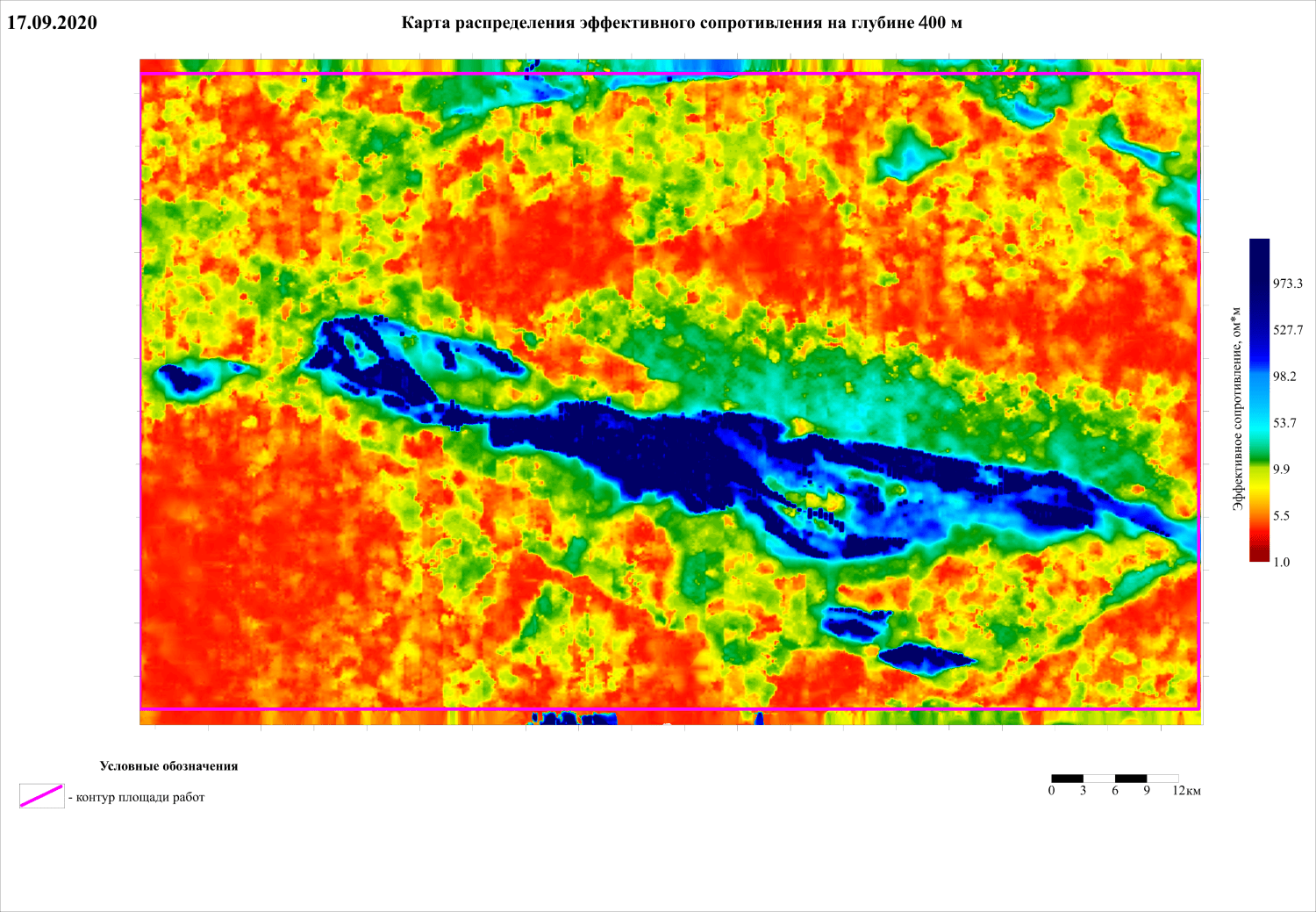
Карта распределения эффективного сопротивления на глубине 400м
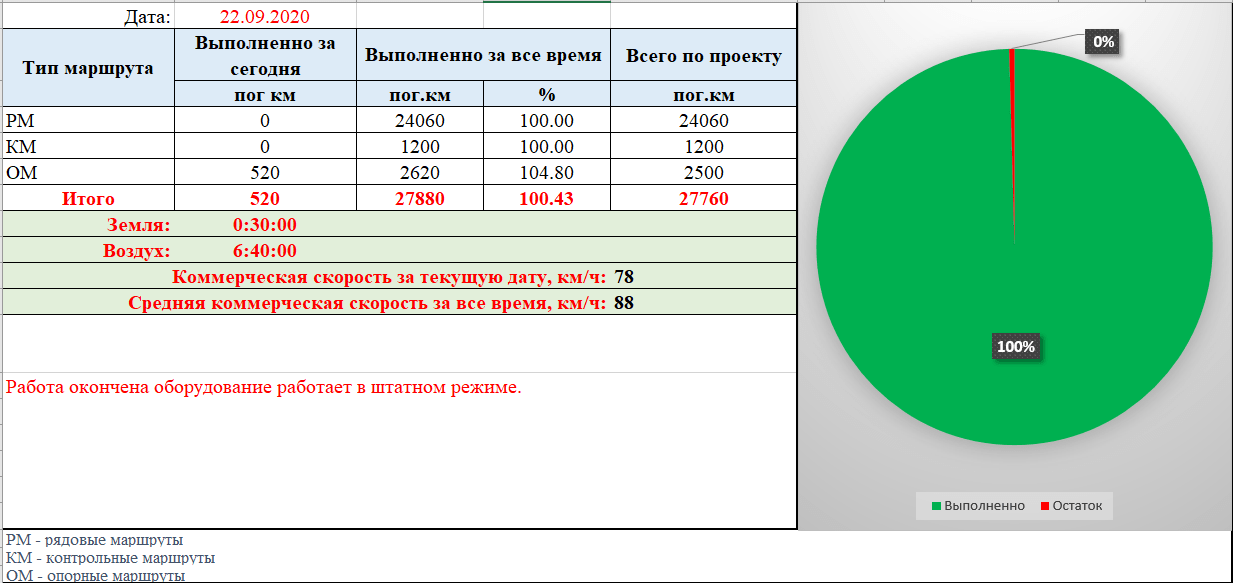
Элемент прогресс-контроля съемки
Место проведения работ
Технология
Оборудование
Поставка вертолетной платформы «Impulse - А150» для Института электроники Китайской академии наук (IE Chinese Academy of Sciences)
2015 - 2020 гг.
PDAC International Convention, Trade Show & Investors Exchange
Торонто, Канада
С 2015 года мы принимаем участие в международной выставке и конференции PDAC International Convention, Trade Show & Investors Exchange. Мероприятие проходит ежегодно в начале марта в г.Торонто, Канада и является одной из крупнейших в мире площадок горнодобывающей сферы, которая концентрирует в одном месте лидеров отрасли (участвуют около 1000 компаний и 24000 посетителей из 130 стран).
Из-за высокого интереса к выставке принять участие со стендом сложно. В 2015 году мы начинали со стенда в Северном здании и уже в 2016 смогли представить свою экспозицию в Южном здании выставки, где сосредоточены основные площадки и тематические мероприятия. Начиная с 2017, вы можете увидеть наши последние разработки и достижения в области поисковых технологий, оборудовании и ПО на стенде 516 в Южном здании.
Благодаря участию в выставке в 2018 году мы заключили договор с Национальным Исследовательским Институтом в Квебеке, и в течение уже двух лет продолжаем сотрудничество: провели совместные исследования по технологии EM-HSDTD® и произвели несколько поставок оборудования серии «Импульс».
3D-ЗСБ ® - технология нового поколения
В 2019 году на PDAC мы представили новую поисковую технологию 3D-ЗСБ ® на основе трёхмерной резистивной реконструкции геологической модели среды в методах ЗСБ и аэро-ЗСБ в объёмное распределение проводимости среды на основе трёхмерного конечно-элементного моделирования и пространственно-распределённых систем наблюдений.
Технология позволяет ставить полноценные 3D-ЗСБ® исследования и добиваться более высокого качества геофизического прогноза по сравнению с традиционными методами. Технология внедрена в системы наземного и воздушного базирования.
Особый интерес у посетителей вызвала система 3D-интерпретации мега-данных аэро-ЗСБ и наземных систем наблюдений. Система основана на численном 3D-моделировании ЭМ-полей. Позволяет строить объемные геоэлектрические модели среды с учётом любой формы рельефа и строения геологической среды.
При интерпретации используются блочные структуры с адаптивными границами, которые подбираются в процессе трехмерной инверсии всей совокупности данных. Достоверность получаемых моделей обеспечивается поворотами блочных структур, что позволяет видеть целевые объекты на фоне множества других неоднородностей.
Программная система работает с более чем 200 тысяч положений точек зондирований и используется также для интерпретации аэро-электроразведки.
Например, для восстановления электрофизических свойств среды при решении задач поиска полиметаллических руд и кимберлитовых тел под траппами используется около 10 тысяч геометрических и электрофизических параметров в вычислительной системе, содержащей 128 ядер.
PDAC 2021 пройдет в Торонто с 7 по 10 марта. Рады видеть вас на нашем стенде
#516.
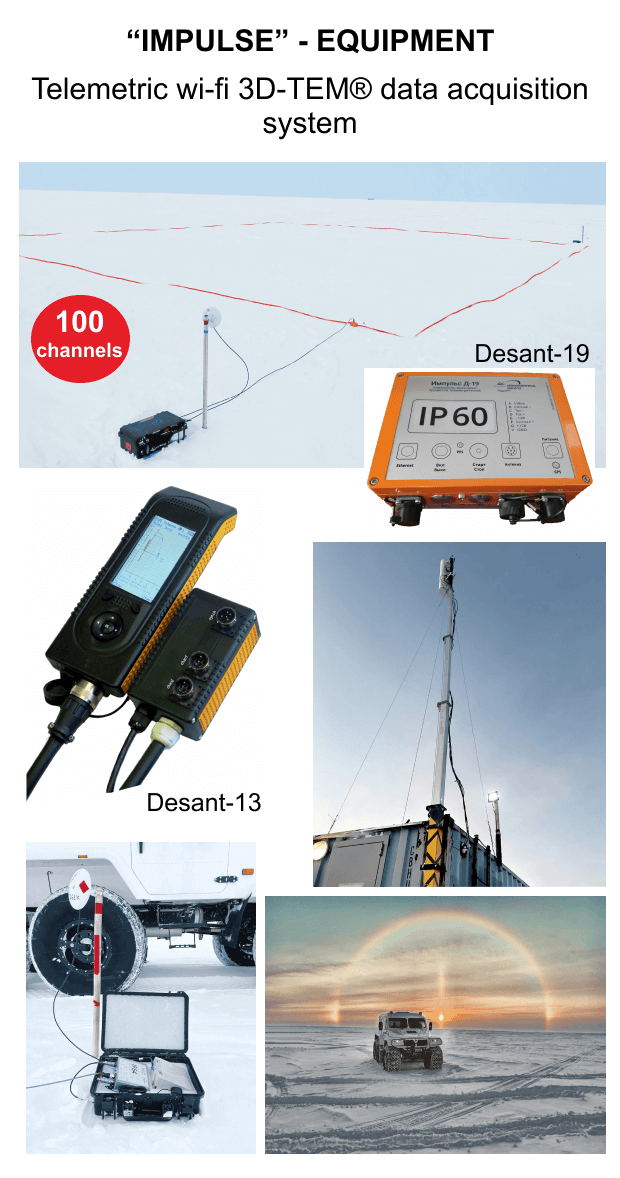
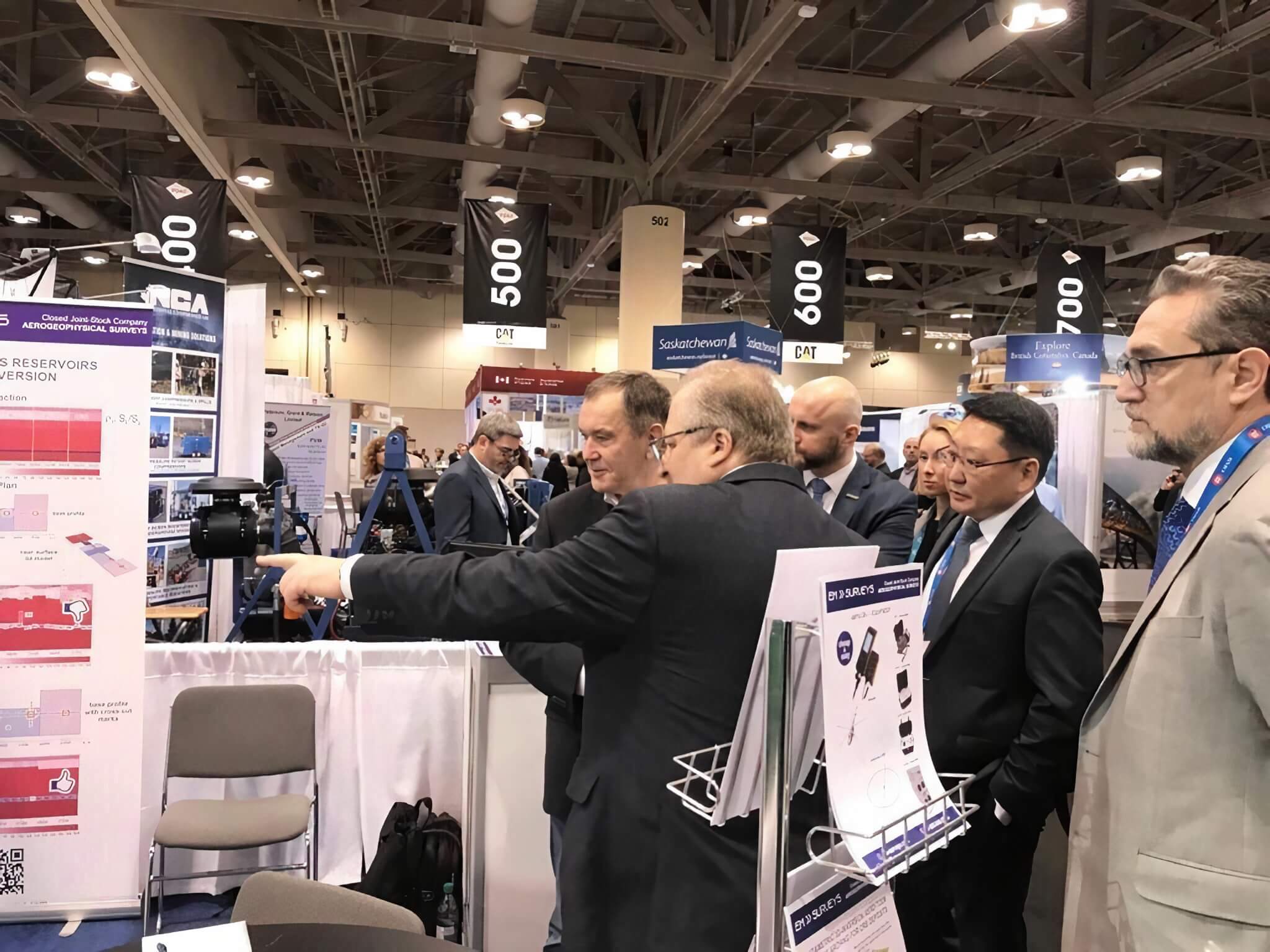

УСЛУГИ
Еще раз о наших услугах , которые , как правило, выполняются "под ключ"

Аэрогеофизика: аэро-ЗСБ, магниторазведка, гамма-ray

ЭМС электромагнитное сканирование во временной области (EM-HSDTD)®

3D – ЗСБ ®

Электроразведка: 2D-ЗСБ , 2D-МТЗ, малоглубинные ЗСБ, П, ЭТ
Особенности
Авторский отчет c подробной верифицированной моделью геологической среды и поисковых объектов в формате действующих стандартов предприятия (ISO).
01
Используем высокоточную 3D – технологию ЗСБ® в полевых работах и интерпретации данных (патенты: РФ 2411549 , РФ 2776893, РФ 2631532, AU 2010303966, CA 2776893)
04
Определяем параметры геологической среды вблизи металлоконструкций (патент № 2528115)
02
Решаем проблемы влияния траппов, ММП, блокового строения среды, влияния геологических и техногенных неоднородностей.
05
Уделяем особое внимание предпроектной стадии работ: строим физико-геологические модели поисковых объектов, определяем закономерность их проявления, предлагаем максимально эффективные методы, проектируем работы
03
Используем технологию разделения индукционной и поляризационной мод в ЗСБ с их последующей раздельной геофизической интерпретацией, что повышает достоверность геофизического прогноза.
06
Наземные исследования
Методы
Оборудование
Решаемые задачи
3D-ЗСБ®, МТЗ, ЭМС, ВП, ЭТ
Электроразведочный телеметрический комплекс серии "Импульс –Д-13", "Импульс –Д-19", "Импульс –Д-20", "Импульс -ВП" , «SyscalPro», MTU-5A (Канада)
• Поисково-оценочные исследования на широкий круг полезных ископаемых;

Стоимость
• Система оценки качества входных данных;
Преимущества
350 - 1500 usd / км съемки в зависимости от масштаба, глубины исследования, поверхностных и климатических условий.
Уточненная стоимость работ предоставляется после изучения нашими специалистами ТЗ и логистики.
Уточненная стоимость работ предоставляется после изучения нашими специалистами ТЗ и логистики.

• Инженерные, гидрогеологические и экологические задачи;
• Мониторинг опасных природных и техногенных процессов;
• Доступная глубина исследований 5000 м условия высоко-проводящего осадочного чехла - 1000 См.
• Определение местоположения и параметров документально утраченных подземных коммуникаций;
• 3D-верификация результата интерпретации.
• Сепарация резистивной и поляризационной мод сигнала;
• 3D-реконструкция изучаемого объема;
• Оценка мерности изучаемой среды;
Электроразведочные работы 3D- ЗСБ® на Ямале
Место проведения работ
ПИ
Назначение работ
п-ов Ямал
УВС
изучение геологического строения в меловых и юрских отложениях. Поиск новых нефтегазоперспективных объектов.
Электроразведочные 3D ЗСБ® исследования проводились по сейсмическим профилям.
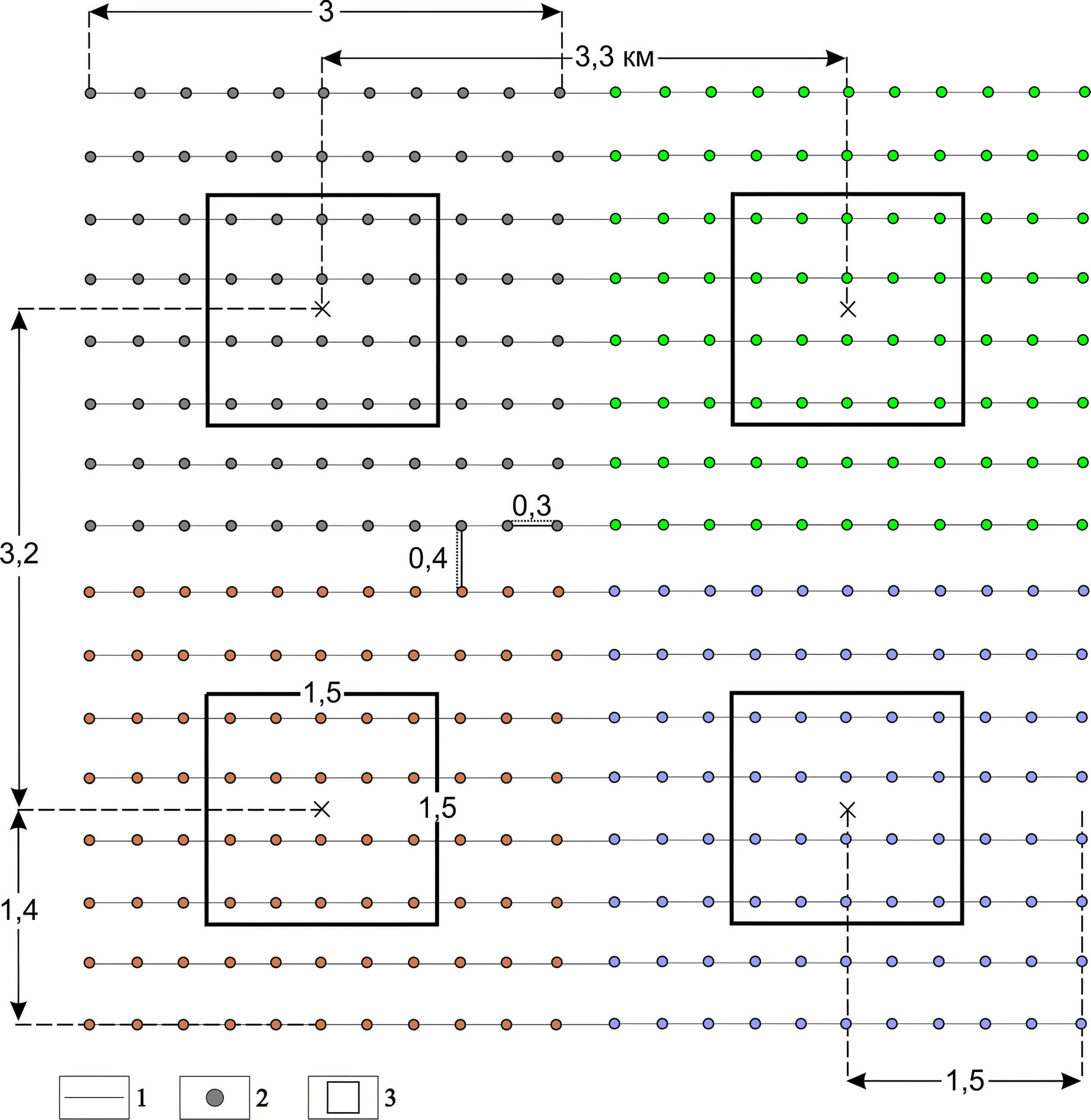
Площадной модуль системы наблюдений 3D- ЗСБ®
Период работ
Оборудование
2019 - 2020 гг.
измерительный телеметрический комплекс «Импульс-Д19»
Технология
3D-ЗСБ®
Генераторный контур (ГК) 1500×1500 м. Амплитуда стабилизирована на уровне 128 А. Индукционные датчики М=10 000 - 50 000 м2. Регистрация переходного процесса от 500 мкс до минимального измеряемого уровня сигнала 0,1 мкВ, на временах около 10 сек. Глубина исследований до 6000 м. От одного ГК одновременно проводится запись 49 физических наблюдений. Шаг между зондированиями 200 - 300 м.
Результаты 3D-ЗСБ®:
В результате выполненных работ 3D-ЗСБ® уточнена геоэлектрическая модель среды до глубины 6000 м , выделены высокопроницаемые коллектора в неокоме и сеномане.
ЭМ-куб электросопротивлений Н = 6000 м , wi-fi – телеметрия
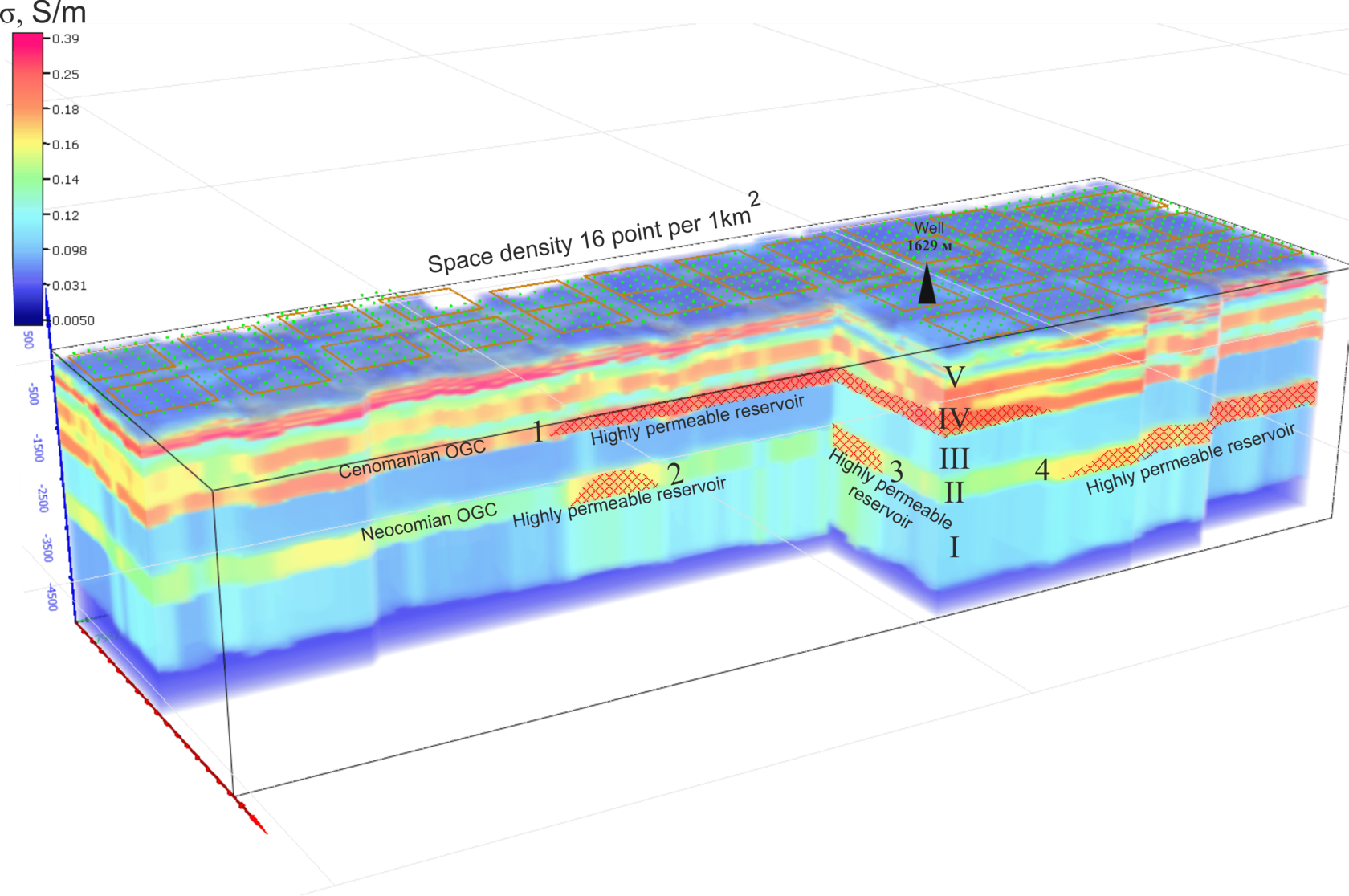
Место проведения работ
ПИ
Назначение работ
Период работ
Оборудование
Технология
Поиск золоторудных объектов в Канаде
Место проведения работ
ПИ
Оборудование
Руэн-Норанда, Канада, провинция Квебек
ЭМС (EM-HSDTD®)
приемно-генераторная конструкция ПГК-36, «Impulse-D13»
Описание работ
Был пройден профиль общей длиной 12 000 м.пог. Профиль разбит на 7 участков.
Технология
золото
Назначение работ
выявление зон повышенной проводимости, приуроченных к возможным залежам графита и золотоносным рудам
Период работ
2019 г.
Результат
На каждом из участков выделены аномалии повышенной проводимости.
На рисунках приведены:
a. Электрограмма сигнала ЭДС, измеренного центральной приемной антенной;
b. CDI (разрез кажущейся проводимости) по сигналам, измеренным центральной приемной антенной;
c. CDI (разрез кажущейся проводимости) по сигналам, измеренным выносной приемной антенной;
d. Электрограмма сигнала ЭДС, измеренного выносной приемной антенной;
e. Распределение в плане сигнала ЭДС, измеренного центральной приемной антенной.
На рисунках приведены:
a. Электрограмма сигнала ЭДС, измеренного центральной приемной антенной;
b. CDI (разрез кажущейся проводимости) по сигналам, измеренным центральной приемной антенной;
c. CDI (разрез кажущейся проводимости) по сигналам, измеренным выносной приемной антенной;
d. Электрограмма сигнала ЭДС, измеренного выносной приемной антенной;
e. Распределение в плане сигнала ЭДС, измеренного центральной приемной антенной.

Приемно-генераторная конструкция ПГК-36
Каркас
Генераторный контур
Коммутатор
Дипольный момент генератора
Количество приемных антенн
Момент приемных антенн
Глубинность*
Расположение приемных антенн
малоглубинный вариант
среднеглубинный вариант
пневматические баллоны
2.5 х 11 м, 1 виток
2.5 х 11 м, 6 витков
2
1 – в центре ГП,
2 – на расстоянии 17м от центра ГП
2 – на расстоянии 17м от центра ГП
КТ-10
КТ-40
275 А×м2
6600 А×м2
2
1 – 50 м2
2 – 100 м2
2 – 100 м2
1 – 100 м2
2 – 100 м2
2 – 100 м2
50 – 100 м
90 – 200 м
пневматические баллоны
1 – в центре ГП,
2 – на расстоянии 17м от центра ГП
2 – на расстоянии 17м от центра ГП
Характеристики

* Глубинность зависит от реального сопротивления среды, указанный в таблице диапазон соответствует диапазону сопротивлений среды 10 – 300 Омм.
Профиль работ

Место проведения работ
ПИ
Оборудование
Технология
Назначение работ
Период работ
Аэрогеофизика
Методы
Оборудование
Тип сырья, задачи
аэро-ЗСБ, магнитометрия, гамма-спектрометрия
вертолетные платформы серии «Импульс-А-150», «Импульс-А-250», «Импульс-А-450» (АГР, Россия), магнитометр на базе датчиков магнитного поля CS-3 и CS-L (Канада), спектрометры RSX-4 и RSX-5 (Канада)
УВС, ТПИ, инженерная геофизика, гидрогеология. Глубина исследований 500 - 600 м.

Стоимость
• Высокая производительность и низкая стоимость по сравнению с наземными методами;
Преимущества, особенности
100 – 250 usd /км
уточненная стоимость работ - после изучения нашими специалистами ТЗ и логистики.
уточненная стоимость работ - после изучения нашими специалистами ТЗ и логистики.
• Работа в труднодоступной местности;
• Аппаратное разделения индукционной и поляризационной мод в ЗСБ. Это позволяет повысить точность ЗСБ и использовать параметр поляризуемости в качестве важного геофизического параметра. Технология не имеет аналогов в стране и сопоставима с лучшими зарубежными образцами.
КАГС при поисках алмазов
Технология
Оборудование
магниторазведка, гамма-спектрометрия, аэро-ЗСБ-fast
аэромагнитометр CS-3 (Scintrex LTD, Канада), спектрометр RSX-5 серии RS-500 (производитель Radiation Solutions Inc., Канада) и электроразведочный комплекс «Импульс-А7» (ЗАО «Аэрогеофизическая разведка», Россия), навигационная система НК «Аэронавигатор плюс» (Аэросоюз», Россия), радиовысотомер РВ-5М, магнитовариационная станция (магнитометр POS-1
Особенности комплекса
Главная отличительная особенность комплекса – высокочастотный электроразведочный канал ограниченной грунтопроникающей способности. Разработанная компанией модификация аэро-ЗСБ-Fast позволила скачкообразно увеличить объем неизвлекаемой ранее информации. Глубинность исследований ограничена 250 м при частоте опроса до 250 Гц.
Влияние ландшафтного фактора и перемещенных валунов с повышенными магнитными свойствами в составе рыхлого чехла.
ПИ
Назначение работ
Период работ
алмазы
создание современной геофизической основы для поисков коренных месторождений алмазов, выделение локальных аномалий, перспективных на обнаружение кимберлитовых тел
2018 г.
Масштаб и объемы работ
1:10 000 на площади 220 кв. км.
Осложняющие факторы
Физико-геологическая модель
Кимберлитовые тела характеризуются выраженной дифференциацией по всем физическим свойствам. В локальном магнитном поле они контролируются контрастными максимумами различной интенсивности (2-12 нТл). По сопротивлению тела маркируются локальными минимумами с относительной амплитудой 25-40 Ом·м. В радиогеохимических показателях кимберлитовые объекты сопровождается яркими ореолами калия (0,4-0,5%) и общей радиоактивности (2,5-3 мкР/ч).
Установлено, что над трубками взрыва, в перекрывающем карбон-четвертичном чехле мощностью 50 м сформированы зоны эпигенеза, представленные трещиноватыми и заглинизированными образованиями. Эти породы достоверно выделяются по электрическим и радиоактивным характеристикам, что также используется для диагностики кимберлитового магматизма. Показана связь трубок взрыва с локальными структурными элементами (купола ограниченных размеров) в кимберлитовмещающих стратонах – дополнительный рудоконтролирующий фактор.
Некоторые результаты работ
По совокупности полученных данных установлено геологическое строение верхней части разреза: выполнено литолого-стратиграфическое расчленение рыхлых и коренных пород до глубины 250 м, выделены кольцевые структуры и промежуточные магматические очаги, контролирующие кимберлитовый процесс, обособлены разрывные нарушения, влияющие на локализацию рудных объектов, и определена их иерархия (порядок и возраст), оконтурены главные и локальные пликативные структуры – маркеры кимберлитового магматизма.
Выполнен статистический анализ геофизических данных различными способами с целью объективного выделения рудоконтролирующих образований. Локализованы аномалии трубочного типа как магнитные, так и электрометрические. Определены их элементы залегания и пространственное положение. Составлена генетическая схема кемберлитового магматизма, охватывающая период от внедрения мантийного плюма в земную кору до образования трубок взрыва и их последующего развития (преобразования).
На основе установленных рудоконтролирующих факторов выделен ряд перспективных геофизических участков (ПГУ), в пределах которых находятся как кусты трубок, так и одиночные объекты. Первоочередные ПГУ в количестве 9 обособлены по полному пакету высококонтрастных поисковых факторов. ПГУ второй очереди (18 шт.) оконтурены по менее выраженным критериям.

Технология
Оборудование
ПИ
Назначение работ
Период работ
Масштаб и объемы работ
Прочие услуги

Комплексная обработка и интерпретация геолого-геофизических данных, построение геолого-геологической модели месторождений.

Супервайзинг наземных электроразведочных и аэрогеофизических работ

Технологическое сопровождение работ, консалтинг

Аренда геофизического оборудования
3D-ЗСБ®
Современное представление о применении ЭМ-разведки базируется на всестороннем учете вмещающей геологической среды и выделение в ней целевых объектов.
Такой подход позволяет решать задачи, которые раньше были недоступны. Если высокая проводимость осадочного чехла, то в комплекс может быть включен МТЗ.
Трёхмерная резистивная реконструкция геологической модели среды в методах ЗСБ и аэро-ЗСБ на основе трёхмерного конечно-элементного моделирования и пространственно-распределённых систем наблюдений позволяет ставить полноценные 3D-ЗСБ® исследования и добиваться существенно более высокого качества геофизического прогноза.
Технология внедрена в системы наземного и воздушного базирования.
Такой подход позволяет решать задачи, которые раньше были недоступны. Если высокая проводимость осадочного чехла, то в комплекс может быть включен МТЗ.
Трёхмерная резистивная реконструкция геологической модели среды в методах ЗСБ и аэро-ЗСБ на основе трёхмерного конечно-элементного моделирования и пространственно-распределённых систем наблюдений позволяет ставить полноценные 3D-ЗСБ® исследования и добиваться существенно более высокого качества геофизического прогноза.
Технология внедрена в системы наземного и воздушного базирования.
3D-интерпретация мега-данных аэро-ЗСБ и наземных систем наблюдений основана на численном 3D-моделировании ЭМ-полей. Позволяет строить объемные геоэлектрические модели среды с учётом любой формы рельефа и строения геологической среды.
При интерпретации используются блочные структуры с адаптивными границами, которые подбираются в процессе трехмерной инверсии всей совокупности данных. Достоверность получаемых моделей обеспечивается поворотами блочных структур, что позволяет видеть целевые объекты на фоне множества других неоднородностей.
Программная система работает с более чем 200 тысяч положений точек зондирований и используется также для интерпретации аэро-электроразведки.
Например, для восстановления электрофизических свойств среды при решении задач поиска полиметаллических руд и кимберлитовых тел под траппами используется около 10 тысяч геометрических и электрофизических параметров в вычислительной системе, содержащей 256 ядер. 3D-процессинг площади порядка 1000 км2 требует около 1000 часов компьютерного времени.
При интерпретации используются блочные структуры с адаптивными границами, которые подбираются в процессе трехмерной инверсии всей совокупности данных. Достоверность получаемых моделей обеспечивается поворотами блочных структур, что позволяет видеть целевые объекты на фоне множества других неоднородностей.
Программная система работает с более чем 200 тысяч положений точек зондирований и используется также для интерпретации аэро-электроразведки.
Например, для восстановления электрофизических свойств среды при решении задач поиска полиметаллических руд и кимберлитовых тел под траппами используется около 10 тысяч геометрических и электрофизических параметров в вычислительной системе, содержащей 256 ядер. 3D-процессинг площади порядка 1000 км2 требует около 1000 часов компьютерного времени.
Регистрация сигналов от вторично индуцированных в геологической среде вихревых токов системой приемных датчиков.
01
Построение аномальных полей и локализация слабых аномалий на поздних временах.
05
Определение участков, соответствующих нормальному полю. В первой итерации нормальное поле – это поле слоистой среды. В последующих итерациях подбирается полная модель ВЧР, удовлетворяющая всем профильно-площадным точкам измерения.
02
Подбор глубинных объектов.
06
Решение обратной задачи для каждой точки регистрации в рамках математической модели соответствующей нормальному полю.
03
Коррекция модели, путем последовательного подбора более слабых отклонений во всей временной области.
07
Программно-математический аппарат
В качестве основного инструмента выполнения обработки и 1D, 3D-интерпретации используется программный комплекс EM-DataProcessor, включающий препроцессинг измеренного сигнала, подсистемы разделения индукционной и поляризационной мод (Каменецкий Ф.М., Тригубович Г.М., Чернышев А.В.), подсистему конечно-элементного моделирования (Соловейчик Ю.Г., Персова М.Г. и др.).
Методы конечно-элементного моделирования используют специальные математические постановки с разделением нормального и аномальных полей и автоматическое построение нерегулярных сеток, что позволяет сократить вычислительные затраты, но обеспечить достаточно высокую точность решений для моделей различной степени сложности.
Методика исследований
Интерпретация данных основана на разделении ЭМ-поля на нормальную составляющую – влияния среды и аномальную составляющую влияния трехмерных неоднородностей.
Одновременный подбор объектов и сигналов по всей пространственно-временной области влияния источника позволяет учитывать неоднородность вмещающей среды, устраняет искажения реконструкции глубинных частей разреза, резко снижает область эквивалентности решения обратной задачи и повышает достоверность прогноза.
Расчет невязки решения обратной задачи и аномальных полей в каждом пункте регистрации. Уточнение модели ВЧР и минимизация невязки до приемлемого уровня;
04
Построение объемной геоэлектрической модели, согласованной с другими геолого-геофизическими данными.
08
Прогноз проницаемости нефтегазовых коллекторов
Предпосылки
уникальные электрофизические свойства коллекторов
Проблема
неоднородная ВЧР
Главная идея
оценка и учет вмещающей среды
Средства
адаптивная ЭМ-разведка на пространственно-распределенных системах наблюдений
3D-реконструкция геоэлектрической модели среды на основе точного мат моделирования.
3D-реконструкция геоэлектрической модели среды на основе точного мат моделирования.
Технология 3D-ЗСБ ®

Под технологией 3D-ЗСБ ® мы подразумеваем приведение в соответствие экспериментальных εе(x, y, t) и теоретических εs(x, y, t) значений отклика исследуемой среды во всей пространственно-временной области одновременно для всех положений приемно-генераторной конструкции путем дискретного подбора объемного распределения проводимости в геологической среде, т. е. минимизация функционала:




Восточная Сибирь
Данные закономерности многократно подтверждены при сопоставления ЗСБ и бурения скважин. ГИС по скважине Чаяндинского НГКМ ( по материалам ИЭРП )

Предпосылки постановки ЭМ-разведки



Исследование точности параметризации геоэлектрического маркера на основе 3D-ЗСБ® – данных


Результаты автоматической поинтервальной 1D-инверсии
Результат 3D-интерпретации с учетом рассечек
1D-TEM
3D-TEM®

Технология 3D-ЗСБ ®
Прогноз коллекторов в условиях насыщенной траппами ВЧР. Геоэлектрический разрез по данным 3D-ЗСБ ®
Результат применения комплекса МОГТ и адаптивной электроразведки 3D-ЗСБ ®: выделены зоны повышенной проницаемости вендского коллектора
Результат применения комплекса МОГТ и адаптивной электроразведки 3D-ЗСБ ®: выделены зоны повышенной проницаемости вендского коллектора



3D-реконструкция геоэлектрической модели среды на апертуре 10×10 км в окрестности параметрической скважины
Проведены площадные исследования ЗСБ+МТЗ с целью актуализации места заложения параметрической скважины. В связи с труднодоступной местностью и ограниченным объемом работ сейсморазведка не проводилась.
Существенные электрические неоднородности были зафиксированы на глубинах до 2000 м. Их параметризация и учет при исследовании продуктивного горизонта позволили провести реконструкцию предполагаемого резервуара на глубине 3670 м (область интереса) и выделить область проницаемых коллекторов (красная область p = 5 Ом·м на фоне 50 Ом·м – для непроницаемых).
ЭМ-исследования были выполнены без рубки профилей по нерегулярной системе наблюдений в объеме 90 пог. профилей ЗСБ и МТЗ. Масштаб 1:50 000.
В результате последующего бурения прогноз по адаптивной технологии ЭМ-разведке был с высокой точность подтвержден. Погрешность определения глубины осевой поверхности коллектора не превышала 3%. Мощность пласта по причине эквивалентности не определена.

3D-реконструкция геоэлектрической модели среды на апертуре 10×10 км в окрестности параметрической скважины
Проведены площадные исследования ЗСБ с целью актуализации места заложения параметрической скважины. В связи с труднодоступной местностью и ограниченным объемом работ сейсморазведка не проводилась.
Существенные электрические неоднородности были зафиксированы на глубинах до 1000 м. Их параметризация и учет при исследовании продуктивного горизонта позволили провести реконструкцию предполагаемого резервуара на глубине 1630 м (область интереса) и выделить выклинивающуюся область проницаемых коллекторов.
ЭМ-исследования были выполнены без рубки профилей по нерегулярной системе наблюдений в объеме 90 пог. км профилей ЗСБ. Масштаб 1:50 000.
В результате последующего бурения прогноз, сделанный по технологии адаптивной ЭМ-разведке, был с высокой точность подтвержден. Погрешность определения глубины осевой поверхности коллектора не превышала 2%. Мощность пласта по причине эквивалентности не определена.

3D-реконструкция геоэлектрической модели среды на апертуре 10×10 км в окрестности параметрической скважины
По малоглубинному ЗСБ в масштабе 1:50 000 создана модель ВЧР. С использованием цифровой модели ВЧР до глубины 1000 м реконструирована 3D-модель глубинная часть разреза по комплексу ЗСБ + МТЗ. В результате в вендских отложениях выделены фрагменты высокопроницаемых коллекторов.

Западная Сибирь

ЭФ предпосылки постановки электроразведки
Менее выражены чем, например, в Восточной Сибири из-за высокой электрической проводимости осадочного чехла, и относительно малых откликов целевых объектов в пределах 5-10 % от суммарного вклада всего осадочного чехла.


ЭМ-куб данных, Ямал , 2019 , ТГМ, H = 6000 М

3D-ЗСБ ® реконструкция геометрии геоэлектрических маркеров без использования данных МОГТ
Выполнена ПОЛНАЯ конечно-элементная реконструкция 3D-ЗСБ ® геометрии и параметров геоэлектрических маркеров в пределах участка. В центре исследуемого участка выделено структурное поднятие (рис.1), характеризующееся благоприятными структурно-вещественными признаками.
На рис. 2 представлена карта продольного сопротивлений по целевому интервалу. В пределах выделенного структурного поднятия по анализу пространственного интервального распределения продольного электрического сопротивления, полученного на основе точного трехмерного конечно-элементного 3D-моделирования, по геометрическому и вещественному факторам, выделена перспективная на УВ-насыщение зона.

Структурная карта по данным 3D-ЗСБ ® по юрскому интервалу Н = 3000 м
Карта продольного электрического сопротивления электроразведки 3D-ЗСБ ® по целевому интервалу


Геоэлектрический разрез по данным полной инверсии 3D-ЗСБ ® вдоль профиля CD

Геоэлектрические разрезы по данным полной инверсии3D-ЗСБ ® вдоль профилей AB, CD, EF, KL


Выделение структур по данным электроразведки 3D-ЗСБ ®
МОГТ Структурный план

Профили МОГТ 2D
Выделение перспективных зон на УВ насыщение по данным электроразведки
Для повышения достоверности локализации продуктивных интервалов осадочного чехла, выделенных по стандарту продольного электрического сопротивления, был дополнительно применен целевой параметр дифференциального сопротивления с корректирующими ГИС- коэффициентами:
дифференциальный параметр Peff, основанный на отношении эффективных толщин исследуемого интервала к общей мощности интервала:
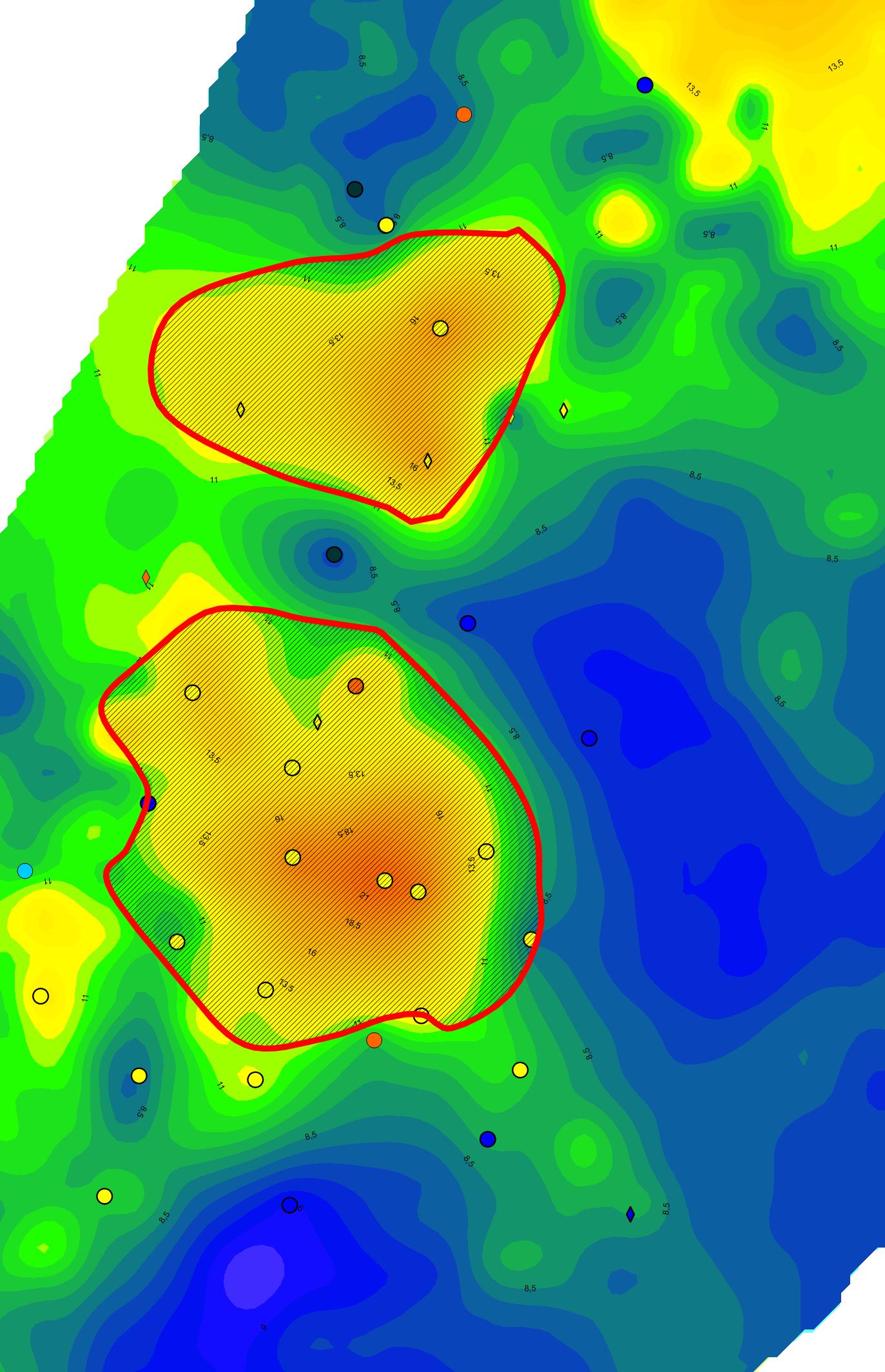

- конечное множество весов, h-мощность интервала, n – количество эффективных пропластков
дифференциальный параметрPpor, отвечающий за распределение коэффициента пористости:

- множество весов, n – количество эффективных пропластков
комплексный параметр Pcomp, отвечающий за отношение суммарной мощности газонасыщенных интервалов к суммарной мощности водонасыщенных интервалов:

- множество весов, n – количество газонасыщенных пропластков, m – количество водонасыщенных пропластков
Далее для каждого исследуемого интервала проводилось преобразование полученных по результатам LCI-инверсии сопротивлений с учетом дополнительной параметризации:

Построены карты дифференциальных сопротивлений по продуктивным интервалам, схемы нефтегазоносности по данным электроразведки.
Карта дифференциальных сопротивлений
Схема нефтегазоносности по данным электроразведки


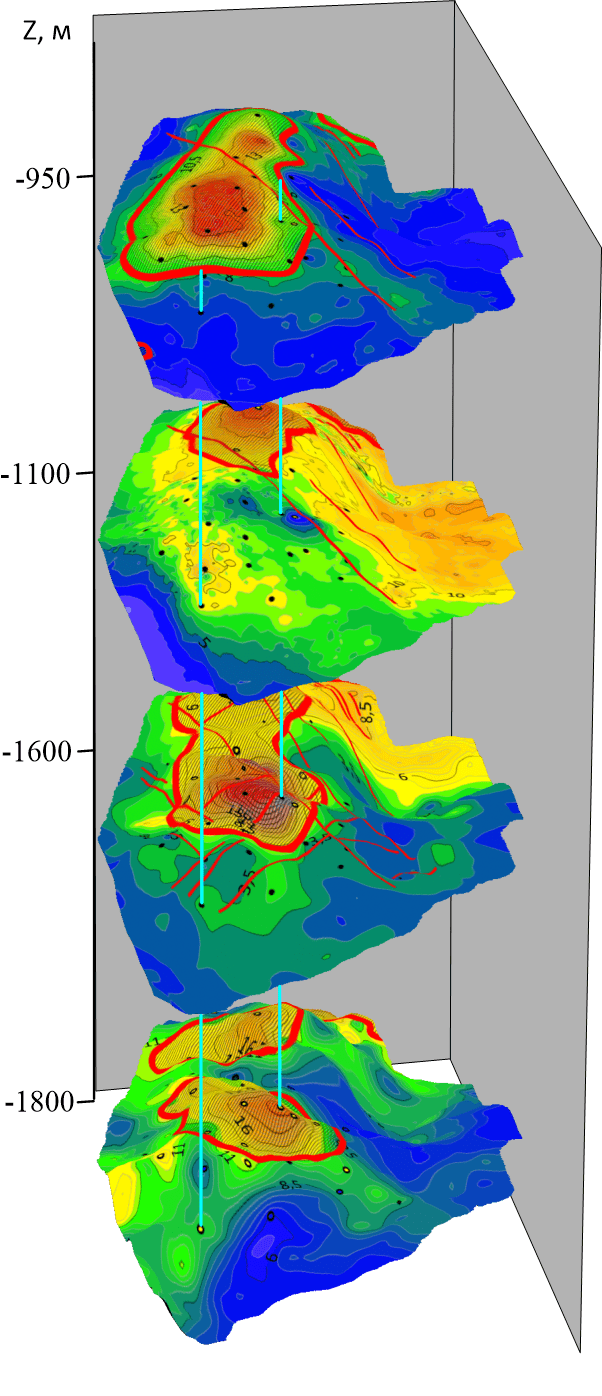
Распределение дифференциальных сопротивлений по целевым интервалам
Технические средства, оборудование, система наблюдений
Подбор распределения удельного сопротивления в перекрывающих слоях с учетом изменяющегося рельефа дневной поверхности и IP эффекта
01
Построение оставшихся невязок наблюденных и расчетных сигналов в области поздних времен
03
Подбор конфигурации и проводимости проводящих объектов на глубине в зонах оставшихся невязок на поздних временных каналах (с соответствующей коррекцией распределения проводимости в перекрывающих слоях).
02
Параметрическая 3D-инверсия данных аэро-ЗСБ при поиске рудных объектов «HeliTem» на одной из лицензионных площадей компании АО «Полиметалл» в Уральском регионе
Cистема 3D обработки больших объемов данных аэро-электроразведки и площадных наземных систем наблюдений основана на численном 3D-моделировании электромагнитных полей и model-based 3D-инверсии. Она позволяет строить геоэлектрическую модель среды с учетом сложного рельефа, переменной толщины латерально-неоднородных слоев и целевых объектов сложной формы.
Достоверность получаемых геоэлектрических моделей обеспечивается возможностью проведения 3D-инверсий с поворотами блочных структур, что позволяет убедиться в устойчивом или неустойчивом выявлении целевого объекта на фоне множества других неоднородностей.
Этапы выполнения 3D-инверсии
Восстановление структуры среды осуществляется с использованием 3D блочных структур с подвижными границами блоков, учитывающих изогнутость и переменную толщину слоев, а также сложную форму целевых объектов. Преимущества программной системы в том, что в процессе 3D-инверсии одновременно могут быть восстановлены как «непрерывно» изменяющаяся электропроводность вмещающих слоев, так и границы отдельных 3D-целевых объектов и крупных геологических структур.
Апробация программной системы проводилась на площадях с системой наблюдений, содержащей около 200 тыс. положений аэросистемы, где для восстановления электрофизических свойств геологической среды использовалось порядка 10 тыс. геометрических и электрофизических параметров при решении задач поиска полиметаллических руд и кимберлитовых тел под траппами. 3D обработка потребовала около 500 часов (20 суток) машинного времени в вычислительной системе, содержащей 128 вычислительных ядер.
Распределение сопротивления в верхней части восстановленной модели

Карта невязок после подбора верхней части разреза при t=400 мкс

Профильные разрезы восстановленной модели

ОТЗЫВЫ
КОНТАКТЫ
630007, г. Новосибирск
Октябрьская магистраль, 4
Ланта Бизнес-центр, офис 1207
Октябрьская магистраль, 4
Ланта Бизнес-центр, офис 1207
Поиск по сайту

ЗАО «Аэрогеофизическая разведка»
ОГРН 1055406366014
ИНН/КПП 5406332567/540601001
Юридический адрес: 630007, г. Новосибирск, Октябрьская магистраль, д. 4, оф. 1207
Почтовый адрес: 630099, г. Новосибирск-99, а/я 299
Телефон: +7(383) 426-47-97
info@aerosurveys.ru
aerosurveys.ru
Обращаем ваше внимание, данный интернет-сайт носит исключительно информационный характер и не является публичной офертой.
Политика конфиденциальности
ОГРН 1055406366014
ИНН/КПП 5406332567/540601001
Юридический адрес: 630007, г. Новосибирск, Октябрьская магистраль, д. 4, оф. 1207
Почтовый адрес: 630099, г. Новосибирск-99, а/я 299
Телефон: +7(383) 426-47-97
info@aerosurveys.ru
aerosurveys.ru
Обращаем ваше внимание, данный интернет-сайт носит исключительно информационный характер и не является публичной офертой.
Политика конфиденциальности


